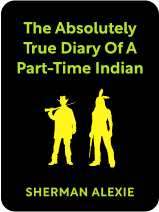

This article is an excerpt from the Shortform summary of "The Absolutely True Diary of a Part-Time Indian" by Sherman Alexie. Shortform has the world's best summaries of books you should be reading.
Like this article? Sign up for a free trial here .
How do the students react to Junior at Reardan in the book The Absolutely True Diary of a Part-Time Indian? Does he fit in, or does he face difficulties at his new school?
The question of “how do the students react to Junior at Reardan” is marked by struggle. Junior faces racism, bullying, and more when he starts at his new school.
So how do the students react to Junior at Reardan? Keep reading to find out.
Junior’s First Days at Reardan
Junior shows up for his first day at Reardan with a black eye and a swollen nose from Rowdy’s “good-bye punch.” Before Junior’s dad drops him off, he tells Junior to remember that the white kids are no better than he is. But they both know that’s not true. Junior knows that they both understand they’re Indians losers “living in a world built for winners.” How do the students react to Junior at Reardan?
As Junior waits for the building to open, the other kids stare at him—he’s the only Indian at Reardan, aside from the school mascot. Once in class, Junior meets blonde, blue-eyed Penelope, the most beautiful girl he’s ever seen. As the teacher calls roll, Penelope asks Junior what his name is. When he tells her, she starts laughing and telling her friends, and Junior realizes that they’re laughing at his name. It’s never occurred to him that he has an unusual name. On the rez, if you walk into a store and call out for “Junior,” seventeen guys and three women will answer.
How do the students react to Junior at Reardan in his class? Things get worse for Junior when the teacher, still calling roll, calls him by his “name name,” Arnold Spirit. Penelope angrily turns back to him and accuses him of giving her a fake name. He tries to explain that his name is both Junior and Arnold, feeling, as he does, like two different people: On the rez, he’s Junior; in Reardan, he’s Arnold.
Getting by at Reardan
(Shortform note: This section includes a quote from the book that uses the N-word. We’re using the word itself because this is a significant moment in Junior’s Reardan experience.)
Junior’s first days at Reardan are lonely. Most of his classmates ignore him. However, a few of the jocks pick on him. They never try to fight him—Junior suspects that even though he’s nerdy, he’s an Indian and, therefore, viewed as a “potential killer.” Instead of fighting him, they call him names like “Chief,” “Tonto,” and “Squaw Boy.”
Initially, Junior ignores them. He’s afraid that if he does get into a fight with these boys who are much bigger than he is, they’ll literally kill him. But this nonviolent attitude ceases when, one day, an older jock named Roger asks Junior if he wants to hear a joke: “Did you know that Indians are living proof that n*ggers fuck buffalo?”
Junior has never heard anything so racist. He feels the need to defend not only himself, but also black people, his fellow Indians, and buffalo. He punches Roger in the face.
Junior backs away and gets into position to continue the fight, but the group of jocks just stares at him, shocked. All Roger can say as the blood comes out of his nose is that he can’t believe that Junior has punched him.
Junior suddenly feels brave. He thinks maybe this is the pivotal moment in his life when he tells the world that he’s no longer willing to be a human punching bag. He tells Roger to meet him at the same spot after school so they can finish the fight, as per the fisticuff protocol on the rez, but Roger tells him he’s crazy, gets up, and walks away.
Junior’s bravery turns into confusion. He’s followed all the Spokane rules of fighting. So why are these boys ignoring him rather than defending their honor? Maybe the rules are different at Reardan? As Roger walks off, Junior calls after him and asks what the rules are. Roger, perplexed, responds, “What rules?” and continues to walk away.
Junior is now confused and terrified. He realizes that Reardan is like a different planet and he doesn’t know how to get back home.
The next morning, Junior’s dad’s best friend, Eugene, sees Junior walking to school and gives him a ride to school on his motorcycle. Roger sees them and approaches Junior after he gets off the bike. Junior’s scared, but to his surprise, Roger just compliments the bike and tells Junior that he’ll see him around. Junior realizes that he’s earned Roger’s respect by punching him.
Hoping to ride the wave of this good luck, Junior sees popular Penelope and says hello. She ignores him. When he says hello again, she sniffs, pretends she doesn’t know him, and then refers to him as the kid who doesn’t know his own name.
How Students React to Junior at Reardan: Penelope Helps
One day, Junior’s bored in class and asks to go to the bathroom. While he’s washing his hands, he hears the sound of someone retching in the girl’s bathroom next door.
How do the students react to Junior at Reardan when he shows he cares? He waits outside the bathroom to make sure the student is ok, and Penelope soon walks out chewing cinnamon gum, trying to cover the smell of vomit. When she asks him what he’s looking at, he tells her, “I’m looking at an anorexic.” She corrects him: She’s bulimic, not anorexic. There’s a difference. “Anorexics are anorexics all the time,” but bulimics are only bulimic when they’re throwing up.
This reminds Junior of the way his father always insists that he’s only an alcoholic when he’s drunk. He tells Penelope the same thing he tells his father when his father is drunk: “Don’t give up.” Junior thinks this advice is kind of corny, but it hits a nerve with Penelope, and she starts to cry. She tells Junior that she’s scared and unhappy but no one allows her to be scared and unhappy because she’s so beautiful and smart. As she tells Junior this, Junior contemplates the size of her ego, but he finds her self-confidence attractive.
After this incident, Junior and Penelope start hanging out and become “friends with potential.” How do the students react to Junior at Reardan after he hangs out with Penelope? Junior knows that she’s only “semi-dating” him because she’s tired of being perfect and dating an Indian gives her a blemish, with the added benefit that it pisses off her racist dad. Junior doesn’t mind that Penelope is using him because, as he sees it, he’s using her, too. Penelope is his way into the social scene at Reardan. Once he starts dating Penelope, he becomes relatively popular.
Penelope and Junior also have things in common: They’re both dreamers who feel trapped in their small towns. Penelope’s dream is to study architecture at Stanford; Junior’s dream is to become a famous artist. They both want to create beautiful things, and they bond over that dream.

———End of Preview———
Like what you just read? Read the rest of the world's best summary of Sherman Alexie's "The Absolutely True Diary of a Part-Time Indian" at Shortform .
Here's what you'll find in our full The Absolutely True Diary of a Part-Time Indian summary :
- How Junior gets split between two worlds when he goes to a mostly white school
- How Junior overcomes being an outsider to being part of welcoming social circles
- The tragedies of alcoholism and poverty that leave Junior with renewed strength






